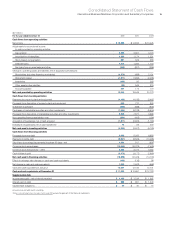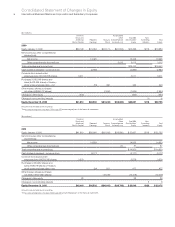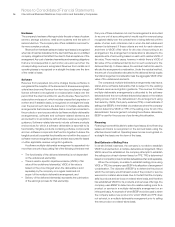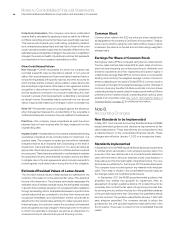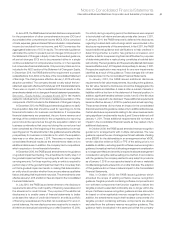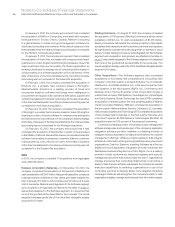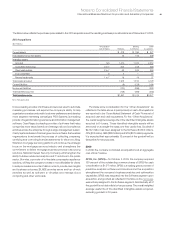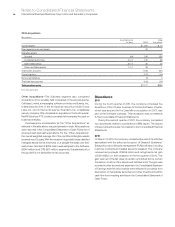IBM 2011 Annual Report Download - page 85
Download and view the complete annual report
Please find page 85 of the 2011 IBM annual report below. You can navigate through the pages in the report by either clicking on the pages listed below, or by using the keyword search tool below to find specific information within the annual report.Notes to Consolidated Financial Statements
International Business Machines Corporation and Subsidiary Companies 83
included in other liabilities in the Consolidated Statement of Financial
Position. To the extent that new information becomes available which
causes the company to change its judgment regarding the adequacy
of existing tax liabilities, such changes to tax liabilities will impact
income tax expense in the period in which such determination is
made. Interest and penalties, if any, related to accrued liabilities for
potential tax assessments are included in income tax expense.
Translation of Non-U.S. Currency Amounts
Assets and liabilities of non-U.S. subsidiaries that have a local
functional currency are translated to United States (U.S.) dollars at
year-end exchange rates. Translation adjustments are recorded in
other comprehensive income. Income and expense items are translated
at weighted-average rates of exchange prevailing during the year.
Inventories, property, plant and equipment—net and other non-
monetary assets and liabilities of non-U.S. subsidiaries and branches
that operate in U.S. dollars are translated at the approximate exchange
rates prevailing when the company acquired the assets or liabilities.
All other assets and liabilities denominated in a currency other than
U.S. dollars are translated at year-end exchange rates with the
transaction gain or loss recognized in other (income) and expense.
Cost of sales and depreciation are translated at historical exchange
rates. All other income and expense items are translated at the
weighted-average rates of exchange prevailing during the year. These
translation gains and losses are included in net income for the period
in which exchange rates change.
Derivative Financial Instruments
All derivatives are recognized in the Consolidated Statement of
Financial Position at fair value and are reported in prepaid expenses
and other current assets, investments and sundry assets, other
accrued expenses and liabilities or other liabilities. Classification of
each derivative as current or noncurrent is based upon whether the
maturity of the instrument is less than or greater than 12 months. To
qualify for hedge accounting, the company requires that the instruments
be effective in reducing the risk exposure that they are designated
to hedge. For instruments that hedge cash flows, hedge designation
criteria also require that it be probable that the underlying transaction
will occur. Instruments that meet established accounting criteria are
formally designated as hedges. These criteria demonstrate that the
derivative is expected to be highly effective at offsetting changes in
fair value or cash flows of the underlying exposure both at inception
of the hedging relationship and on an ongoing basis. The method of
assessing hedge effectiveness and measuring hedge ineffectiveness
is formally documented at hedge inception. The company assesses
hedge effectiveness and measures hedge ineffectiveness at least
quarterly throughout the designated hedge period.
Where the company applies hedge accounting, the company
designates each derivative as a hedge of: (1) the fair value of a
recognized financial asset or liability or of an unrecognized firm
commitment (fair value hedge attributable to interest rate or foreign
currency risk); (2) the variability of anticipated cash flows of a forecasted
transaction or the cash flows to be received or paid related to a
recognized financial asset or liability (cash flow hedge attributable
to interest rate or foreign currency risk); or (3) a hedge of a long-term
investment (net investment hedge) in a foreign operation. In addition,
the company may enter into derivative contracts that economically
hedge certain of its risks, even though hedge accounting does not
apply or the company elects not to apply hedge accounting. In these
cases, there exists a natural hedging relationship in which changes
in the fair value of the derivative, which are recognized currently in
net income, act as an economic offset to changes in the fair value
of the underlying hedged item(s).
Changes in the fair value of a derivative that is designated as a
fair value hedge, along with offsetting changes in the fair value of the
underlying hedged exposure, are recorded in earnings each period.
For hedges of interest rate risk, the fair value adjustments are
recorded as adjustments to interest expense and cost of financing
in the Consolidated Statement of Earnings. For hedges of currency
risk associated with recorded financial assets or liabilities, derivative
fair value adjustments are recognized in other (income) and expense
in the Consolidated Statement of Earnings. Changes in the fair value
of a derivative that is designated as a cash flow hedge are recorded,
net of applicable taxes, in other comprehensive income, in the
Consolidated Statement of Comprehensive Income. When net
income is affected by the variability of the underlying cash flow, the
applicable offsetting amount of the gain or loss from the derivative
that is deferred in equity is released to net income and reported
in interest expense, cost, SG&A expense or other (income) and
expense in the Consolidated Statement of Earnings based on the
nature of the underlying cash flow hedged. Effectiveness for net
investment hedging derivatives is measured on a spot-to-spot basis.
The effective portion of changes in the fair value of net investment
hedging derivatives and other non-derivative financial instruments
designated as net investment hedges are recorded as foreign
currency translation adjustments in other comprehensive income.
Changes in the fair value of the portion of a net investment hedging
derivative excluded from the effectiveness assessment are recorded
in interest expense. If the underlying hedged item in a fair value hedge
ceases to exist, all changes in the fair value of the derivative are
included in net income each period until the instrument matures.
When the derivative transaction ceases to exist, a hedged asset or
liability is no longer adjusted for changes in its fair value except as
required under other relevant accounting standards. Derivatives that
are not designated as hedges, as well as changes in the fair value of
derivatives that do not effectively offset changes in the fair value of
the underlying hedged item throughout the designated hedge period
(collectively, “ineffectiveness”), are recorded in net income each
period and are reported in other (income) and expense. When a
cash flow hedging relationship is discontinued, the net gain or loss
in accumulated other comprehensive income must generally remain


